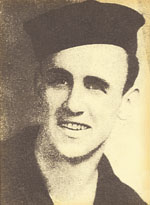 (In honor of Veterans Day this month, we present this account of what it was like to be a Merchant Marine during World War II by Elwood DeHority, a consumer of LaGrange County REMC. The photo at right is of DeHority in 1943.)
(In honor of Veterans Day this month, we present this account of what it was like to be a Merchant Marine during World War II by Elwood DeHority, a consumer of LaGrange County REMC. The photo at right is of DeHority in 1943.)A turning point in my life happened 65 years ago when I tried to join the Navy. It was 1943, in the middle of World War II.The Navy turned me down and persuaded me to join the Merchant Marines — sailors who were charged with transporting supplies overseas.The Navy recruiters neglected to tell me the Merchant Marines had the highest casualty rate of any other service — or that this particular branch of service wasn’t considered part of the military.Unaware of this important piece of information, I, at age 18, joined the Merchant Marines. I was sent to a Coast Guard training station in Sheepshead Bay, Brooklyn, N.Y., for my six weeks of training.
Sheepshead Bay is next to the Atlantic Ocean. While there, I could hear loud explosions out in the ocean. [The Germans] were sinking ships no more than 10 minutes out of the New York Harbor! I was scared knowing it wouldn’t be long before I would be going out in the same water.
I did cross the very dangerous North Atlantic several times, and I witnessed ships sink after getting torpedoed.
As a Mariner, I was on the scene of a number of historic events. During one mission, we carried millions of gallons of aviation fuel on board a tanker enroute to Algiers, North Africa. On deck, there were a lot of P38 aircraft. We hit a violent storm and about half of the aircraft went overboard. To top off this “adventure,” while we were in Algiers there was an air raid. If a bomb would have hit the ship, I believe it would have burned down the town. That was when German General Rommel was in North Africa.
I was also a part of the invasion of Normandy, France on June 6, 1944. I was on a supply ship in the English Channel at the time of the invasion. I could hear the large guns from the battleships.
The day after the invasion, we were sent into London to pick up soldiers to take to LaHarve, France. After we unloaded in LaHarve, we loaded wounded soldiers to take back to London. We loaded soldiers whose legs and arms had been cut off. Most of them were on stretchers. Some were near death.
We made that trip several times. On one of those trips, a torpedo from a U-boat just missed the bow of our ship by not more than 30 feet.
Civilians in danger
The Merchant Mariners’ role in World War II has not received a lot of press. But I believe the Nazis would have taken England if it wasn’t for the United States supply line provided by the Merchant Marines. And after the Nazis took England, their next target would have been the United States.
However, as important as our job was, we were classified as civilians during the war. What other groups of civilians — that numbered in the thousands — faced the kind of danger we did? Every time we left port, we were a target. German U-boats actively tried to shut off the supply line, mostly going to England and Russia. England was our lifeline for a buildup of material for the invasion of France.
The Germans were sinking our ships at about 33 a week. We lost 1,764 ships and about 9,300 Merchant Mariners. They were killed and buried at sea. These Mariners lay on the ocean floor in unmarked graves without an official MIA list.
There were also 11,000 Merchant Mariners wounded during the war. Six hundred sixty-three were taken prisoner. Sixty-six died in prison camps. Thirty-one ships vanished without a trace.
Mariners were the first to go and the last to return, with 240 killed before the attack on Pearl Harbor. Countless others were killed by mines after VE and VJ Day. I laughed when they gave us shark repellent, not that it would have done any good. A Merchant Mariner faced unfathomable dangers. The ridiculousness of the shark repellent just doesn’t go away.
One in 26 Mariners serving aboard merchant ships in World War II died in the line of duty. Mariners suffered the greatest percentage of war-related deaths than all other branches of the U.S. services.
As soon as Germany declared war on the United States on Dec. 12,1941, U-boats headed for the Atlantic coast. The U.S. did not arm the ships or provide escorts or air cover. The U.S. did not organize convoys along the Atlantic, gulf coasts or the Caribbean.
The U.S. government did not order a blackout of the seacoast cities until June 1942 which left our ships silhouetted against the shore lines. Allied ships were sitting ducks for the well-armed U-boats lurking in U.S. coastal waters. U.S. beaches soon became littered with bodies and burned-out ships. There were over 145 ships sunk within 10 miles of our shoreline.
In his book, “The Second World War,” Winston Churchill said the only thing that ever really frightened him during World War II was the U-boat peril to the United States.
It’s ironic my final memory of World War II was actually translated into one of the most famous images of that time. On Sept. 2, 1945, I happened to be on the shore in New York City, just back from a trip to England. I was on Times Square when the message on the Times Building reported the war was over. Remember the photo of the sailor kissing the nurse? I actually saw the sailor grab that nurse and kiss her. I was less than 10 feet from them!
Victory for the seamen
Congress passed the Merchant Marine Act of 1936 stating Merchant Mariners are civilians except in times of war. At that point, they become part of the United States military personnel. But during World War II and the Korean conflict the act hadn’t been observed.
In 1988, a group of Merchant Mariners successfully sued the U.S. government for the right to be called veterans. Their lawsuit was a victory for the seamen, although there are only about 7,000 World War II-era Merchant Mariners still alive.
A year or so ago, I watched the TV show “The War” about the battles in the Pacific and France. They never mentioned there wouldn’t have been any battle if it wasn’t for the Merchant Marines. It was the Merchant Marines that hauled all the equipment overseas. Yet their contributions continue to receive little recognition.
Elwood DeHority continued to serve his country after World War II. Since he was at the time technically a civilian, he was drafted into the Army in 1952 and served in Korea for 20 months. The LaGrange County REMC member has been honorably discharged from the Coast Guard and the Army and has received a certificate of service. DeHority now lives in Howe.

The American Merchant Mariners’ Memorial in New York City’s Battery Park was inspired by a photo of victims of a Nazi submarine attack on an American merchant ship during World War II. The monument honors all the Merchant Mariners who died at sea. Photo by Richard Biever




